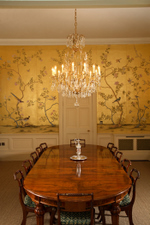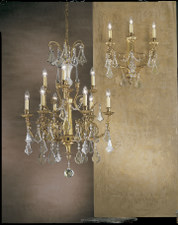Trends in Lighting for Period Houses - by Christopher Hyde the classical lighting expert
The vogue for decorating houses in the style and furnishings of a previous era was not always thought important by our ancestors.
Until the advent of mass production lighting in the Victorian period, most homes were still lit with
rush lamps. Decorative candle lights, such as chandeliers and wall sconces, were only to be found in the homes of the aristocracy and rich merchant classes. As these items were very expensive they were handed down from one generation to the next: even when the architecture of the house was altered in line with current fashion. When electricity was widely introduced into homes in the 1920’s, many of the existing fittings were simply adapted.

Left: the Ghent chandelier based on the original Dutch and Flemish style of chandelier in the 17th century.
Hence, a Regency house could have a Baroque chandelier and Chinoiserie table lamps, and a Victorian villa could boast French Empire styled chandeliers complete with military motifs or Egyptian sphinxes. I advocate a similar approach today, and recommend lighting is chosen as much to suit the furniture and soft furnishings, as the age of the property.
So what are the current trends in classical lighting? Can there be any trends in a sector that looks to the past for its design inspiration? After all, period styled lighting, such as Regency or Georgian fittings, is designed to reflect well-recorded historical periods of architecture and décor, so one could assume that today’s taste and fashion in interiors has little relevance. Yet, I would advocate that the sector continues to develop and is influenced, not only by trends in interior design, but external forces such as the economy and major exhibitions put on by The Royal Academy and the Victoria & Albert Museum, which heighten public interest in any given historical era or movement – myself included.

Left: the Georgian styled Carlton crystal chandelier in a dining room decorated in the Chinoiserie style.
It would be fair to say that trends in luxury, classical lighting evolve over some considerable time – we are talking about years not months, particularly as working on new designs and fabrication techniques can take up to couple of years to perfect. A good example would be the V&A’s excellent Arts & Crafts exhibition back in 2005, which was very popular and acclaimed at the time; today, some six years later, the likes of Voysey, Benson and Morris are celebrated in several collections of quality light fittings on the market, which successfully emulate their style. Likewise, an earlier Art Déco exhibition inspired a flurry of new fittings, which in turn created a renewed interest amongst home owners and Interior Designers.
W.A.S. Benson is regarded as a leading designer of the Arts and Crafts movement and is renowned for his art metal ware, in particular oil, gas and electrical light fittings. The Christopher Hyde Benson Collection of two table lamps and one wall lamp is a tribute to Benson’s style. All are made from cast brass in bespoke finishes, with glass shades.

Left: TR966 Tall Scroll Table Lamp: diameter 210mm, height 465mm shown in soft gold finish
Also available:
TR967 Small Table Lamp: diameter 160mm, height 335mm
WR966 Wall Light: back-plate diameter 95mm, projection 270mm, height 300mm
Currently, the London house market appears to be having a subtle influence on new lighting designs. It is noticeable that as the correlation between the cost of houses and their size appears to go in opposite directions, where a decade ago you could purchase a sizeable period property for three quarters of a million pounds, whereas today the same outlay will purchase a Victorian, small, worker’s cottage, this in turn is influencing lighting styles. Interested and well informed, the purchasers of the Victorian cottages are equally likely to invest in period lighting commensurate with the purchase price of the house, as their counterparts did a decade ago, and so there is a noticeable increase in requests from Interior Designers for smaller scaled, but still high quality, light fittings, suitable for such properties.

Knightsbridge collection small sized crystal chandelier and wall sconce, mid 19th century in style.
Likewise, the current woes of our economy are widely discussed, and with no quick fix in sight some have decided to invest in property rather than watch their savings languish in the bank generating little interest. Purchasing a period, country home is one solution and my experience is that new owners, including overseas’ purchasers, are looking to invest in their property and add value by re-instating original features, including period lighting.
The role of the Interior Designer is very influential in such projects, as the soft furnishings selected will often influence the finish and style of light fittings chosen. Over the last year, we have seen a gradual shift away from the dark bronze and pewter light fitting finishes, which work so well with richly toned fabrics and wallpapers, and instead lighter gold, silver plate and soft, warm bronze finishes are in vogue, which complement the more delicate tones of some of the new collections.
The classical lighting sector may well have its feet firmly in the past, but I believe its success lies in its continued versatility, which ensures it remains in tune with current style trends.
Christopher Hyde has a classical lighting showroom at Chelsea Harbour Design Centre; he also accepts special commissions. For further information T: 0207 351 0863 www.christopherhyde.com
Press enquiries contact:
Fay Handley
T: 01295 724177 M: 07790 659983 This email address is being protected from spambots. You need JavaScript enabled to view it.













